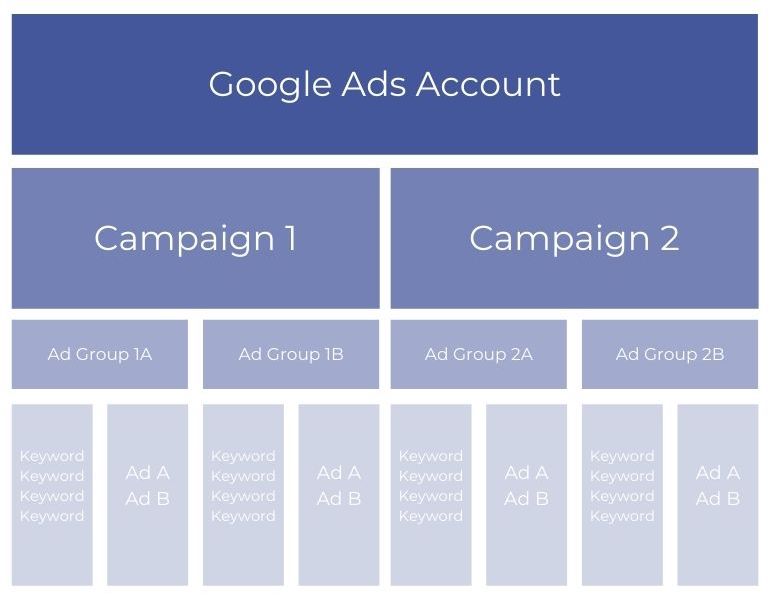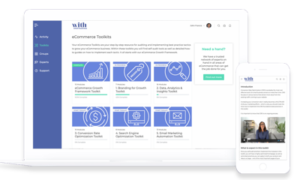What is a Google Ads campaign structure?
Whether you’re ready to build a brand-new Google Ads account from scratch or want to overhaul a messy account, here are some key points to consider:
- Start with a strong foundation. Give your campaign structure and settings the attention they deserve.
- Ad groups are simply containers, but they’re very important to control keyword and ad association.
- Make your keywords work for you. Start with modified broad match keywords (2-3 terms in each keyword) that show clear intent.
- Write ad copy that sets you up for conversions and always be testing!
- Remember ad extensions are your friends. Choose wisely and don’t start spending money until they’re enabled.
Your Google Ads campaign structure consists of 5 important elements:
- The campaign level
- The ad group level
- Keyword selection
- Ad copy
- Ad extensions
In the end, you should have a campaign structure that looks like this:

Why have a campaign structure in place?
The way you structure your Google Ads account allows you to control how you want your ads to be triggered and when and where you want them to appear. Not having a well-structured account is like attempting to drive a car that’s not properly built – accidents are bound to happen. Keep in mind that having a well-structured account will:
- Ensure that the searches triggering your ads are relevant for your audience.
- Result in better quality scores, which in turn results in better results and lower prices. Quality score is essentially the scale of how much Google likes you (and trust me, you want Google to love you!).
- Keep you organized and able to optimize. If your account is a mess, then you’re likely to get lost in the mess, your results will plummet (or never arrive) and optimizing to get better results will be out of the question. So keep in mind organization (and your own sanity) when structuring your account.
It’s important to have a full understanding of each component of your ads account structure before getting started, so let’s quickly review the basics:
- Campaigns: How to structure Google Ads campaigns, in a nutshell: Unless your account is very large, you’ll typically only have a few campaigns that surround broader themes. Each campaign will contain ad groups, which contain keywords that tie to your text ads and direct to your landing page. Typically we recommend deciding on campaign topics based on how you want to divvy up your marketing budget since you set up your budget at the campaign level.
- Ad Groups: Under each campaign, you will create relevant ad groups, which will be much more specific. There’s no recommended number of ad groups to have under a campaign, but typically it’s more manageable to not go overboard since this will stretch your campaign budget across so many ad groups, keywords, ads, and landing pages, that results could suffer. Ad groups contain keywords (no more then 10-20 is recommended), these keywords will trigger your text ads (2-3 per ad group), and then direct to a relevant landing page.
- Keywords: Keywords will fall under each ad group, and are very important to controlling the way your ad is triggered. When someone types in the search box in Google, that search is called a “search query,” which is then matched with a keyword, which then triggers an ad. Each keyword will have a maximum CPC, match type, and quality score tied to it. It’s critical to conduct thorough keyword research, gain a concrete understanding of match types, and spend time refining and optimizing your keyword strategy over time.
- Negative Keywords: These are vastly overlooked by advertisers, but they’re critical to set up and build upon to avoid spending money on irrelevant searches. Especially if you’re using more broad match and/or modified broad match keywords, you’re highly likely to pull in some completely irrelevant search queries that match with your keywords and ads. Keep building your negative keywords list and checking out your search query report (or QueryStream for WordStream users) to identify new negatives.
- Ad Text: This is the actual text that will appear when your ad is triggered. Each ad group should have 2-3 ads per ads per group directing to the same landing page. It’s important to follow Google Ads guidelines in order to get your ads approved, A/B test your ads over time, and really highlight the benefits of your offering to one-up your competition in the search results.
- Landing Pages: Last, but not least, we have landing pages. The destination where each ad will direct the searcher to (likely a page on your site with an offering or call-to-action). We recommend being very strategic with your landing pages, making sure that each ad directs to an extremely relevant page, which reflects not only the keywords you are bidding on within that ad group, but also the ad text displaying in the SERPs. Landing page relevancy and optimization are critical to see success with PPC.


